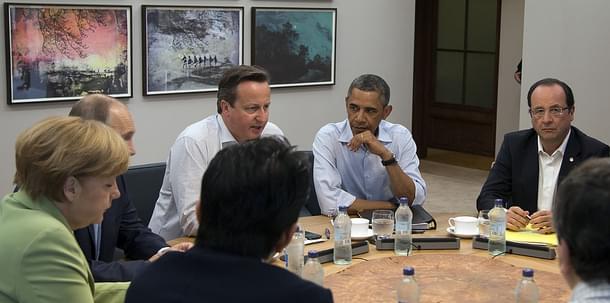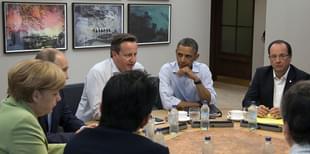Economy
Trade And Finance: How The Developed World Is Setting The Rules Which Hurt Countries Like India
K.N. Vaidyanathan and Akshay Mathur
Jul 29, 2016, 02:47 PM | Updated 02:47 PM IST
Save & read from anywhere!
Bookmark stories for easy access on any device or the Swarajya app.


The globalisation of trade in goods has expanded to trade in services, investment and labour, and this has created a new dynamic of economic exchanges between countries. To accommodate these new areas of global integration, international agreements— earlier limited to rules like cross-border tariffs— are also expanding. As a result, many countries are increasingly negotiating regulations that were once the domestic domain of governments. This has engendered a “regulatory diplomacy”, which has become the central focus of economic engagement worldwide, with wide-ranging implications.
The shift in the nature of international agreements is most evident in the evolution of three areas: global financial standards, plurilateral trade agreements and regional economic unions. In all three areas, the harmonisation and reciprocal recognition of national and provincial regulations are being intensely negotiated across global fora like the G20, the Financial Stability Board, the Association of Southeast Asian Nations (ASEAN) and among countries signing up for trade agreements like the Trans-Pacific Partnership (TPP).
India has underestimated the scope and scale of this global transition and remains constrained by capacity required to steer the global dialogue in its favour. As a result, the international regulatory architecture is crystallising in a way that is not in India’s strategic economic interests.
I. Global Financial Standards And The Monetary System
Since the 2008 Trans-Atlantic financial crisis, there has been a focus on re-engineering global financial regulations. The G20-backed Financial Stability Board (FSB) has introduced measures to:
(i) Enforce capital adequacy in banks in the form of the Basel 3 norm, introduced in 2013.
(ii) ring-fence the “too-big-to-fail” banks (now called the Global Systemically-Important-Financial Institutions or G-SIFI).
iii) monitor “over-the-counter” derivatives for transparency.
(iv) subjugate shadow banking or the unregulated intermediaries in the system.
But these priorities are only relevant to developed, western economies. Not a single Indian financial institution qualifies as a G-SIFI. Moreover, the “one-size-fits-all” approach to capital adequacy for banks does not work for countries such as India, which need investments for infrastructure and growth. India’s markets regulator, the Securities and Exchange Board of India (SEBI) has protested about this. India is ahead of the West in derivative contracts which are already traded, cleared and settled on exchanges in India, providing transparency that is unmatched globally. Shadow banking accounts for less than 15 percent of India’s total financial assets but is revered by small enterprises because its socio-economic reach fills a void in the formal banking system.
India could accrue some benefit from these initiatives if it uses these rules to drive internal reforms. For instance, Basel 3 has new technical regulations for measuring risk (for example, measuring risk with mark-to-market loss indicators for counterparties, leverage ratios that measure off-balance sheet leveraging) that can be adopted to monitor non-performing assets— a known problem in India and other countries like China.
What matters to countries like India are:
(i) the regulation of globally-referenced benchmarks like the London Interbank lending rate (LIBOR), the Euro Interbank Offered Rate (EURIBOR) and the Tokyo Interbank Offered Rate (TIBOR) which undergird the $220 trillion of financial products globally, including India.
(ii) the reform of credit rating agencies (that were central to the 2008 crisis).
Global institutional investors interested in investing in India still have to resort to investment-grade rating assessments by private multinationals like Fitch, Moody’s and Standard & Poor’s to assess creditworthiness of even small businesses and infrastructure projects. This effectively blocks the estimated $70 trillion of global long-term capital from being used productively in India.
The developed world is also ignoring India’s long-term demand for better coordination of monetary policies globally. The fear amongst emerging markets of the spill-over effects of the U.S. Federal Reserve’s monetary policy on currencies remains. The Governor of the Reserve Bank of India (RBI), Raghuram Rajan, has repeatedly called for a new, Bretton Woods-like agreement on monetary policies. But, so far, the U.S. Federal Reserve and its counterparts in other advanced economies have shown no interest in this proposal, and continue restricting themselves to narrow mandates of ring-fencing their own economies— in direct contradiction to the G20’s spirit of collaborative, global economic governance.
II. Plurilateral Trade Agreements
Global trade negotiations have expanded from tariffs and duties to cover a much wider range— including harmonisation between countries of regulations on services, state-owned enterprises, e-commerce, labour and the environment. The proposed Trans-Pacific and Trans-Atlantic mega-regional trade agreements have catalysed this push. India and China are not a part of either agreement but both will be impacted if these rules become the template for all trade agreements negotiated globally in the future.
Some of the new measures will, for example, limit public-sector companies from raising finance from their national government. This will be detrimental for India, whose public-sector companies are core to its national and foreign economic interests. It will also impact a large part of the world where the public sector plays a central role in the economy.
Other measures propose to make standards set by foreign private entities influential in the design and enforcement of regulations across countries, and create a legal basis for their adoption. For instance, the U.S. and Europe-based Forest Stewardship Council has helped design the environment regulations for the TPP. If adopted globally, these rules will impact India’s export of furniture and handicrafts due to the difficulty of proving the legal harvest of timber in India.
Similarly, the provisions in the TPP for Investor-State Dispute Resolution indicate a preference for foreign private law firms and organisations as the arbitrators for settling disputes between governments and business. If this becomes the norm, it will bypass local court systems everywhere. It could particularly disadvantage and disfavour countries like India whose governments lack expertise in, and finance for, foreign arbitration.
On the other hand, India would have willingly supported proposals within the emerging regulatory frameworks in areas of its comparative strength, such as services or labour. Free movement of natural persons (Mode 4) has been India’s long-standing request at the World Trade Organisation, but it continues to be ignored at that forum.
To counter these gaps, India can introduce measures on labour in the Regional Comprehensive Economic Partnership (RCEP), on which it is collaborating with China and ASEAN as a response to the TPP and TTIP. Unfortunately though, this regional effort has no creative counter-measures and the RCEP will, at best, be a melding of existing FTAs in goods.
III. Regional Economic Unions
In addition to the harmonisation of trade regulations is another set of complex economic arrangements, where regulatory inter-operability between countries is the basis of economic exchange.
The European Union exemplifies this the best— both the pros and cons of regulatory harmonisation. While common rules enabled the free flow of goods, services, people and capital across EU countries, weak management also made the Union susceptible to systemic risks and asymmetric accumulation of economic benefits. This resulted in the Eurozone crisis of 2010 and Brexit, respectively.
Despite centrifugal forces such as negotiations with Greece pressing for a disintegration of the common market, the EU’s response to the Eurozone crisis was to introduce the “Banking Union” which empowers the European Central Bank to regulate Eurozone banks by using common policies. This approach confirms that more, not less, regulatory integration was deemed necessary for successful financial globalisation.
A more recent example is the launch of the ASEAN Economic Community (AEC), parented by the ASEAN secretariat. Just like the EU, the AEC aims to establish a single market for goods, services, capital markets, and even the movement of skilled labour— all through harmonisation or mutual recognition of each other’s regulations.
The AEC is in the process of establishing the ASEAN Banking Integration Framework (ABIF) by which a bank in one ASEAN country will become a local bank across ASEAN (“ASEAN Bank”), with preferential regulations. This will especially threaten the western banks that currently dominate the cross-border financial system in Asia.
Similarly, the ASEAN Insurance Integration Framework (AIIF) and the ASEAN Capital Market Infrastructure (ACMI) have been conceptualised to integrate the functions of underwriting and clearing settlement across ASEAN member countries. A systematic harmonisation of cross-border regulations on licensing requirements, accounting standards, minimum capital requirements, large exposures and consumer protection, is in process.
By October 2015, the AEC had already achieved 92 percent (469 of 502) of its goals, with the most progress made on measures required to make the AEC a single market.
Such regional unified markets will compete aggressively with India for capital, talent, and business, attracted by the $2.6 trillion ASEAN market— the third largest in Asia and seventh largest in the world.
In contrast, India does not even have a domestically harmonised regulatory system—and the common Goods and Services Tax (GST) is a dire necessity. Nor have India’s regional economic ambitions— for example, in the South Asian Association for Regional Cooperation (SAARC)— or mutual recognition agreements fructified (for example, an India-ASEAN FTA in services), leaving us behind the curve.
Meanwhile, this evolution of regulatory architecture in international finance, plurilateral trade and regional economic unions confirms that regulatory diplomacy has emerged as a core component of statecraft. India has an advantage here— its regulatory agencies such as SEBI, the Insurance Regulatory and Development Authority (IRDA) and RBI are capable and credible. Now is the time for India to use that strength to influence the design of the evolving global regulatory framework. This can secure India’s international economic interests while the country builds its domestic economy and consolidates its economic integration with the world.
This article was first published by Gateway House: Indian Council on Global Relations. You can read the original article here.
K.N. Vaidyanathan is the Adjunct Senior Fellow, Geoeconomics Studies at Gateway House: Indian Council on Global Relations, Mumbai and EVP & Chief Risk Officer of Mahindra and Mahindra, India. He was the Executive Director at the Securities & Exchange Board of India.Akshay Mathur is the Director of Research and Geoeconomics Fellow at Gateway House: Indian Council on Global Relations.





